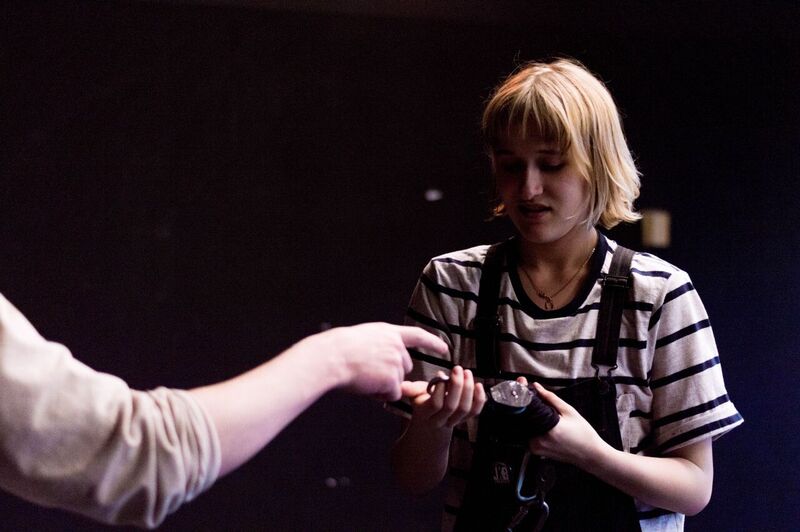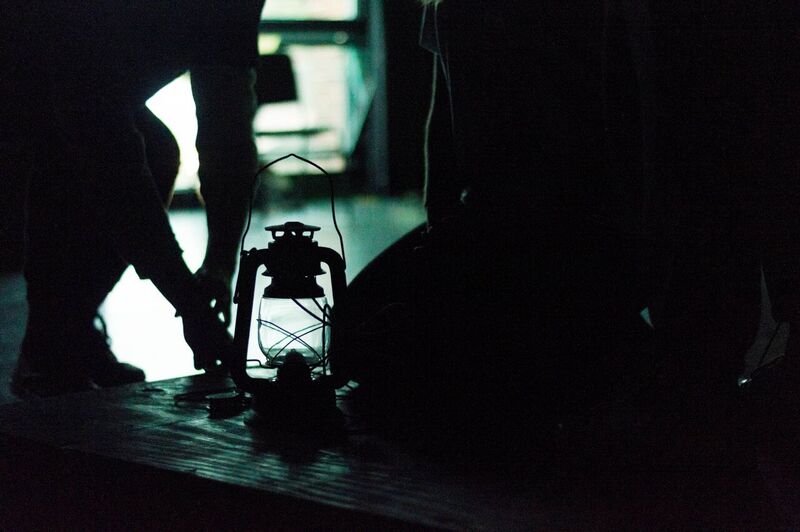Fragmentation and Isolation: The Visceral Success of Multi-Media Storytelling in Adore
By Kallan Dana
How terrible it is to watch someone fall into loneliness.

Photo by Dante Haughton ’19
Michael (Ethan Embry ’19), begs his estranged partner, Elizabeth (Hannah Curtis ’20), for a second chance. Elizabeth is non-respondent. As she coldly stares back, she appears to magically drift away from him—a physical parallel for the emotional distance between the two characters. Before Michael can process the end of this relationship, they have separated, and the lights fade.
Adore, the multi-media New Works Lab written by Jack Mulhern ’17, is comprised of several short filmed and staged scenes. All exist within the same world and feature the same characters, but they do not follow one clear, linear plot. Instead, we see people mid-conversation, slowly discovering information about them in disjointed scenes.
In every conversation the characters have, they seem to withhold secrets from one another, or at least fail to tell the full story. An ominous mood arises out of the constant alternation between mediums. Half the time the scenes take place in film, projected on one wall of the studio, and the other half are staged on black platforms which are pulled in and out of the space by offstage hands. The duality of storytelling methods evokes a sense of fragmentation, and indicates that we will not be provided a full explanation for each individual’s actions. The discontinuous form of the narrative suggests something further about the internal lives of the characters—that they are truly isolated, lonely, and unalterably disconnected from each other.
Adore allows you to respond without thinking, drawing upon the evocative nature of film. We see recurring shots of a wedding, a forest, a church, with eerie, whispered voiceovers underneath. While it is initially hard to discern the immediate relation of these images to the rest of the piece we are watching, it ultimately does not matter; the visuals produce a visceral reaction that is satisfying and troubling. They stand alone, without need for explanation.

Cast member Finley Martin ’19, Photo by Dante Haughton ’19
The film frequently shifts focus, prioritizing each character’s narrative in turn. Early on, we watch Macey (Finley Martin ’19), a neurotic woman, confess to the mysterious Z (Olivia Bagg ’19), that she believes her refrigerator to be haunted. The scene is undeniably funny, and yet the earlier voiceover and visuals we have seen establish a foreboding atmosphere. In a later scene, Macey packs up to leave her apartment, tucking her key under a rock outside her door. Seconds after she has walked out of sight, Michael approaches, watching her leave, and takes her key to enter her apartment. Watching Michael meander through Macey’s home, sitting on her couch, pocketing her rent money, one cannot help but think back to Macey’s earlier fears. We begin to wonder who to trust, and whose story we are following. How do these characters know each other, and why do their plots intertwine?
Which brings us back to the topic of loneliness. Of all the characters, Michael perhaps seems the most lost and confused. After trespassing on Macey’s property, he steals a bike and rides victoriously down the middle of the street, beaming and laughing. The sequence is almost a cinematic cliché—the music swells, and, for a moment, it’s easy to indulge in romantic fantasies of escape and independence. Before long, however, the conventionality of this scene is entirely subverted—Michael stumbles, half-naked out a remote motel room, approaches a bonfire, and stares at it, worryingly alone. We see him alone once more, at the end of the film, silently sitting on a log in the woods. The other characters walk in the background, watching him closely but moving past him without approaching. Is he aware of their presence? Are they really there? Is he really there? It all feels unreal, and we’re left not knowing, exactly, from where these characters came or to where they will go.

Photo by Dante Haughton ’19
Adore relishes in ambiguity. In its refusal to provide obvious answers, it mirrors the limits of human communication. Often times, the weight of the characters’ interactions lies in what goes unsaid. Each scene is short and leaves us yearning for a neat, orderly conclusion which we will not receive. The staged scenes heighten this sense of incompleteness, as characters are pulled out of conversations by forces beyond their control, the wheeled platforms they stand on moving as scenes carry on. The show’s resistance to narrative resolution combats much of what we desire out of our relationships with others, but it also touches upon the melancholy beauty of isolation. Yes, it is terrible to watch someone fall into loneliness, but it is also profoundly familiar. The limits of these characters are the limits of ourselves, and if loneliness is painful, it is also, at least, understandably and inescapably human.
***
Kallan Dana ’19 is an English/Theater double major and Staff Writer for the Living Newsletter.
